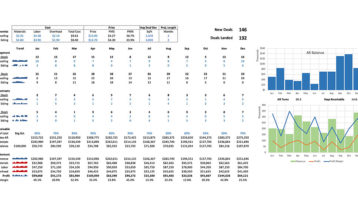5 Ways Real-Time Financial Reporting Mitigates Enterprise Risk

This article is part of our multi-part series about the challenges that CFOs face going into 2021. Please be sure to check back for other posts in the series coming soon.
2020 brought with it a series of events that have increased volatility and risk for most businesses. Even before the coronavirus disrupted supply chains and shifted priorities, business leaders understood the need to identify and monitor the factors that could have an impact on their enterprises.
Clear visibility of what’s happening in the organization requires reliable tools and sound processes for reporting events and conditions in real time. Let’s look at some of the key risk categories that are often encountered by growing businesses.
Credit Risk
Under any conditions, cash is a top priority for business leaders, but when the shutdowns of early 2020 began to take effect, it soon shot to the top of the list. Even for companies that remained open, with strong demand for their products, concerns about the cascading effects of business insolvency loomed large.
Suppliers of food and beverage products for restaurants and institutions, for example, had ample reason to be concerned about potential bankruptcies among their debtors. At the very least, they could expect that customer payments might be delayed as cash-starved businesses struggled to pay their bills.
Companies that take a disciplined approach toward A/R collections will inevitably have healthier cash flow than those that do not. But internal priorities can sometimes be in conflict, as the company seeks to maximize revenue while limiting its exposure to losses from bad debts. The sales organization is often incentivized on top-line revenue, but in many cases, salespeople may have little or no visibility to collections.
Finance, on the other hand, focuses on cash and leverage. Of course revenue matters, but only if it can be converted to cash in a timely manner. More and more organizations are balancing these apparently conflicting agendas with collaborative processes that span the two departments. When real-time A/R data can be made readily available to sales, and when sound processes and approval thresholds are in place, the company can continue to drive top-line revenue while limiting credit risk significantly.
An area of particular concern is credit risk concentration. In other words, if a single customer owes you a lot of money and that customer goes bankrupt, it can have a major impact on your business. In this respect, the tension between sales/revenue priorities and the financial risk associated with credit concentration tends to be especially pronounced. After all, it is often the largest customers that comprise the largest numbers making up your accounts receivable balance.
In order to limit credit risk, including credit concentration risk specifically, finance teams should put rigid processes into place to capture real-time events that may impact A/R and collections. That includes access to up-to-the-minute information on aged balances and payment status, as well as sales quotations, pending orders, and even the sales opportunity pipeline. After all, if next month’s sales forecast is driven by a spike in expected orders from a large customer that could perhaps be placed on credit hold, it’s important for managers to be aware of that fact before it becomes a problem.
Standard CRM and ERP reports won’t give you that information, though; business leaders need to proactively identify potential areas of credit risk and build safeguards to prevent them from turning into crises. When you put powerful self-service reporting tools into the hands of the finance team, that becomes possible.
Revenue Concentration Risk
As the COVID crisis began to take hold, product demand radically shifted across multiple industries. Companies serving the automotive, airline, or cruise ship industries have seen a drop off in revenue, for example. One impact of that sudden shift in demand was the amplified credit risk already discussed. But for many companies, the crisis also highlighted a dangerous lack of diversity in their sources of revenue. It’s risky for a business to be very reliant on a single customer, a single industry, or a single product category.
In 2020, a number of companies abruptly shifted direction, opening new lines of business and/or selling their products through new channels. Large cosmetics companies, for example, saw brick-and-mortar sales plummet, while online sales (surprisingly) rose significantly. Manufacturers of store fixtures responded to the sudden new demand for acrylic shields to provide safe separation between retail personnel and the customers they serve. Restauranteurs reconfigured their operations to accommodate takeout meals.
Perhaps more than ever before, business leaders have sought ways to diversify their sources of revenue and mitigate risk. In 2021, agility will continue to be the overriding mandate for enterprises seeking to survive and thrive in the years ahead.
Agility calls for new ways of doing things, as well as clear visibility to business events as they are happening in real time. Flexible, self-service, real-time reporting tools support business agility by helping managers to better understand conditions on the ground and to develop and update “what if” scenarios with ease. With such ad hoc analyses, business leaders are in a much better position to evaluate potential new sources of revenue, customer engagements, or business model extensions.
Compliance Risk
In the article “Use Real-Time, Self-Service Financial Reporting to Address 2021 Compliance Issues”, insightsoftware covered a range of compliance issues that will receive increased attention from business executives in 2021 and beyond. Those include reporting to banks and other lenders, compliance with government grant programs, and management of external audits.
One of the greatest areas of compliance risk for many organizations, however, arises from regulatory oversight. That includes the ability to provide evidence that processes are being followed faithfully, as well as tracing the provenance of source materials and notifying customers of potential product safety issues.
The financial repercussions of compliance failures can be significant. The reputational damage, likewise, can be devastating, especially in the case of high-profile events. Flexible real-time reporting tools enable managers to monitor the factors that play an important role in compliance.
Price Volatility Risk
Another result of the coronavirus pandemic was a sudden disruption in global supply chains. Plant shutdowns and raw materials shortages have had a cascading effect in some industries. The availability of pressure-treated lumber, for example, initially caused prices to skyrocket. That was soon followed by shortages in other lumber materials as well.
The construction industry, which has been especially hard-hit by the pandemic, has also been grappling with dramatic swings in other raw materials. Shortages of LVT, rolled rubber, cement, and other critical supplies have been widely reported over the past year.
For large-scale projects, that makes it very difficult to provide accurate cost estimates. If volatility reaches a critical level, it can even create the risk that projects may be canceled.
In some industries, it’s common to hedge price volatility risk with financial instruments such as futures contracts. This is especially true where commodities comprise a major component of the value chain, but in many industries, that kind of hedging is simply not practical. Again, the key to managing and controlling price volatility risk requires clear visibility to “what if” scenarios based on up-to-the-minute business conditions. That, in turn, requires powerful and flexible analytical capabilities.
Financial Risks: Interest Rate and Exchange Rates
While the world has been enjoying low interest rates for a number of years now, you may still remember periods in the not-too-distant past when interest rates and inflation were well into the double digits. Although most experts predict that interest rates will remain low for some time to come, others have suggested that inflationary pressure may pick up steam as the economy returns to normal.
For companies doing business internationally, exchange rate fluctuations likewise pose a risk, particularly if the business holds assets (including accounts receivable) denominated in foreign currencies. While it is relatively easy to manage a company’s exposure to exchange rate fluctuations, managers first need to be aware of that exposure. Again, that’s where flexible, real-time reporting tools can help.
Reduce Your Dependency on Manual Reporting Processes
For most organizations, reporting consumes too much staff time because it requires tedious manual processes like copying and pasting information from exported CSV files or system reports or entering information by hand into Excel spreadsheets.
Those kinds of processes also introduce errors, leading to a lack of confidence in the information being reported. Business leaders consistently express frustration at the difficulty of getting clear information out of their software systems in a timely way. When an organization has clear, accurate, timely information based on real-time data, everyone in the business can operate according to a single version of the truth. That means the management team can spend less time arguing about the numbers, and more time solving problems and improving business results.
Insightsoftware provides financial intelligence tools for over 140 different ERP systems. For nearly three decades, we have been helping business leaders get the information they need, quickly, accurately, and efficiently. If your organization is struggling to gain visibility to your risk exposure, contact us today to schedule a free demo.









